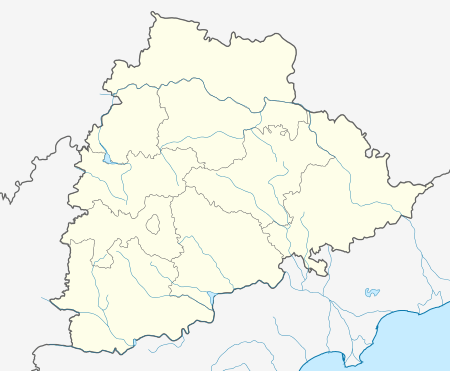Bodhan
| Bodhan | |
|---|---|
| Town | |
 Bodhan Location in Telangana, India  Bodhan Bodhan (India) | |
| Coordinates: 18°40′N 77°54′E / 18.67°N 77.9°ECoordinates: 18°40′N 77°54′E / 18.67°N 77.9°E | |
| Country | India |
| State | Telangana |
| District | Nizamabad |
| Government | |
| • Type | Municipal Council |
| • Body | MLA |
| Area[1] | |
| • Total | 21.40 km2 (8.26 sq mi) |
| Elevation | 357 m (1,171 ft) |
| Population (2011)[2][3] | |
| • Total | 77,553 |
| • Density | 3,600/km2 (9,400/sq mi) |
| Languages | |
| • Official | Telugu, Urdu |
| Time zone | UTC+5:30 (IST) |
| PIN | 503 185, 503 180 |
| Telephone code | +91–8467 |
| Vehicle registration | TS 16 |
| Website |
bodhanmunicipality |
Bodhan is a town in Nizamabad district of the Indian state of Telangana.[2] Bodhan is primarily known for the Nizam Sugar Factory and some historical sites.
History
Bodhan is identified as the ancient Podana town, which was probably the capital of Vinayaditya, an 8th century ruler of the Vemulavada Chalukya dynasty.[4] Bodhan is believed to be the birthplace of the dynasty's Kannada-language court poet Pampa.[5] The samadhi (burial place) of Pampa is also believed to be located at Bodhan: it was discovered in the 1970s, when historian Yadagiri Rao deciphered a form of the old Kannada script. The samadhi is of an unidentified saint, who is believed to be Pampa.[6]
Demographics
As of 2011 India census,[7] Bodhan had a population of 77,573. Males constitute 50% of the population and females 50%. Bodhan has an average literacy rate of 66%, lower than the national average of 74.04%; with male literacy of 71% and female literacy of 61%. 11% of the population is under 6 years of age.
Revenue Division
Bodhan is one of the 68 revenue divisions of Telangana state. It consists of six mandals namely Bodhan, Varni, Rudrur, Kotagiri, Renjal and Yedapally. The entire division comes under ayacut of Nizamsagar Project
Government and politics
Civic administration
Bodhan Municipality was constituted in 1952 and is classified as a second grade municipality with 35 election wards. The jurisdiction of the civic body is spread over an area of 21.40 km2 (8.26 sq mi).[1]
References
- 1 2 "Urban Local Body Information" (PDF). Directorate of Town and Country Planning. Government of Telangana. Retrieved 28 June 2016.
- 1 2 "District Census Handbook – Karimnagar" (PDF). Census of India. pp. 11, 36. Retrieved 11 June 2016.
- ↑ "Census 2011". The Registrar General & Census Commissioner, India. Retrieved 25 July 2014.
- ↑ Jaisetty Ramanaiah (1989). Temples of South India: A Study of Hindu, Jain, and Buddhist Monuments of the Deccan. Concept. p. 22. ISBN 978-81-7022-223-1.
- ↑ Countdown to World Telugu Conference begins
- ↑ Kannada aadikavi Pampa’s samadhi lies in ruins at Bodhan
- ↑ "Census of India 2011: Data from the 2011 Census, including cities, villages and towns (Provisional)". Census Commission of India. Retrieved 2016-07-18.